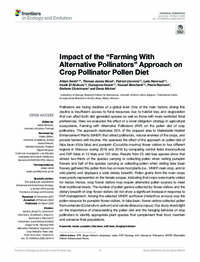Impact of the “Farming With Alternative Pollinators” Approach on Crop Pollinator Pollen Diet

Authors:
Pollinators are facing declines at a global level. One of the main factors driving this decline is insufficient access to floral resources due to habitat loss and degradation that can affect both diet generalist species as well as those with more restricted floral preferences. Here we evaluated the effect of a novel mitigation strategy in agricultural ecosystems, Farming with Alternative Pollinators (FAP) on the pollen diet of crop pollinators. The approach dedicates 25% of the cropped area to Marketable Habitat Enhancement Plants (MHEP) that attract pollinators, natural enemies of the crops, and provide farmers with income. We assessed the effect of the approach on pollen diet of faba bean (Vicia faba) and pumpkin (Cucurbita maxima) flower visitors in four different regions in Morocco during 2018 and 2019 by comparing control fields (monoculture) and FAP fields in 13 trials and 101 sites. Results from 25 wild bee species show that almost two-thirds of the species carrying or collecting pollen when visiting pumpkin flowers and half of the species carrying or collecting pollen when visiting faba bean flowers gathered this pollen from two or more host plants (i.e., MHEP, main crop, and/or wild plants) and displayed a wide dietary breadth. Pollen grains from the main crops were poorly represented on the female scopae, indicating that crops were mainly visited for nectar. Hence, crop flower visitors may require alternative pollen sources to meet their nutritional needs. The number of pollen genera collected by flower visitors and the dietary breadth of crop flower visitors did not show a significant increase in response to FAP management. Among the selected MHEP, sunflower (Helianthus annuus) was the pollen resource for pumpkin flower visitors. In faba bean, flower visitors collected pollen from coriander (Coriandrum sativum) and canola (Brassica napus). Our study sheds light on the importance of characterizing the pollen diet and the foraging behavior of crop pollinators to identify appropriate plant species that complement their food, maintain and conserve their populations.
